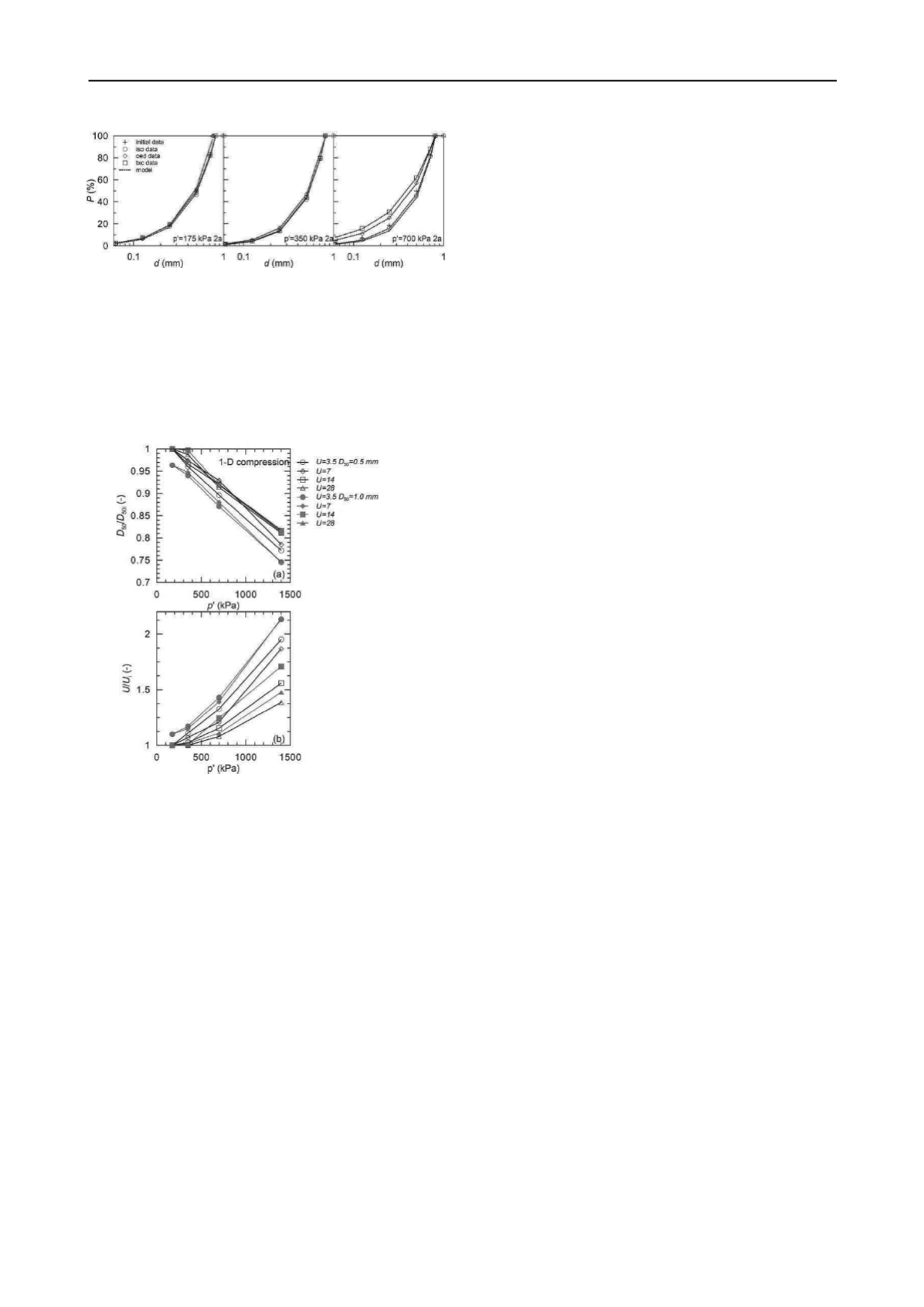
210
Proceedings of the 18
th
International Conference on Soil Mechanics and Geotechnical Engineering, Paris 2013
Proceedings of the 18
th
International Conference on Soil Mechanics and Geotechnical Engineering, Paris 2013
Figure 10. Grain size distribution evolution with
U
= 3.5 and
d
50
= 0.50
mm.
Grain crushing has been quantified, as a first approximation,
using the ratios between
d
50
/
d
50i
and
U
/
U
i
, where
d
50i
and
U
i
represent respectively the initial mean diameter and coefficient
of uniformity. Figure 11 (a) and (b) show the evolution for the
ratios
d
50
/
d
50i
and
U
/
U
i
after 1-D compression for all of the
initial GSDs tested, as a function of maximum mean effective
stress
p
'.
Figure 11. Evolution of ratios: (a)
d
50
/
d
50i
and (b)
U
/
U
i
with mean
effective stress applied in 1D-compression.
The reduction of
d
50
/
d
50i
with increasing
p’
is more pronounced
for samples with lower initial coefficient of uniformity (
U
i
=
3.5) and higher mean diameter (
d
50i
= 1 mm). Likewise, as the
initial
U
decreases, the ratio
U
/
U
i
increases by a factor greater
than 2 for the poorly graded samples with the greater d
50i
. The
ratio
U
/
U
i
is consistently higher for higher initial mean diameter
(
d
50i
= 1 mm) for all the GSDs tested, which is probably due to
the lower coordination number of the particles. The stress acting
on the neighbour is higher for the same magnitude and direction
of stress applied, as the coordination number decreases, as
larger particles tend to be cushioned by surrounding smaller
particles. This leads to higher coordination numbers and makes
the larger particles more resistant to crushing. Smaller particles,
with smaller coordination numbers, are more likely to be
crushed in the fragmentation process so that the cushioning
effect for larger particles is more relevant than the lower particle
strength with increasing particle size.
3 CONCLUSIONS
An extensive laboratory investigation has been conducted on an
artificial granular, expanded clay pellets LECA, composed of
grains that break at relatively low stresses. These lightweight
expanded clay aggregates are used in road construction,
tunnelling, structural backfill against foundations, retaining
walls and bridge abutments, because of their low unit weight
and good drainage properties. In many practical cases, the stress
levels to which the material is subjected are comparable to those
explored in the present experimental investigation.
The final grain size distribution measured after loading is
rotated upwards and translated leftwards (on a standard particle
size distribution plot) for all tested samples. The percentage of
finer particles increases with increasing mean effective stress
and stress-path obliquity. The grain size distributions can be
described satisfactorily using simple equations derived from a
fractal evolution of grading. Breakage has been quantified as a
first approximation through the evolution of non-dimensional
ratios of mean diameter and coefficient of uniformity. Poorly
graded samples show more pronounced decrease in mean
diameter and increase of uniformity with higher stress applied.
Further investigations will be undertaken to reproduce the
observed behaviour through a constitutive model to account for
breakage and its effects on mechanical behaviour.
ACKNOWLEDGEMENTS
The authors are grateful to Ralf Herzog (Institute for
Geotechnical Engineering) and Gabriele Peschke (Institute for
Building Materials), ETH Zurich, for their technical support.
REFERENCES
Casini, F. and Viggiani, G.M.B. (2011). Experimental investigation of
the evolution of grading of an artificial material with crushable grains
under different loading conditions.
Proc. Int. Symp on: Deformation
Characteristics of Geomaterials
, IS-Seoul 2011, 957-964.
Casini F., Viggiani G.M.B. and Springman S.M. (2013). Breakage of an
artificial crushable material under loading.
Granular Matter
(submitted).
Cho G., Dodds J. and Santamarina J. (2006). Particle Shape Effects on
Packing Density, Stiffness, and Strength: Natural and Crushed Sands.
J.
Geotech. Geoenviron. Eng.
, 132(5), 591
–
602.
Hardin, B.O. 1985. Crushing of soil particles.
Journal of Geotechnical
Engineering
, ASCE 111(10), 1177
–
1192.
Imre B., Laue, J. and Springman, S.M. (2010). Fractal fragmentation of
rocks within sturzstroms: insight derived from physical experiments
within the ETH Geotechnical Drum Centrifuge.
Granular Matter
12(3):
267-285. DOI: 10.1007/s10035-009-0163-1.
Imre B., Wildhaber, B. and Springman, S.M. (2011). A Physical
Analogue Material to Simulate Sturzstroms.
IJPMG
. 11(2): 69
–
86.
doi:10.1680/ijpmg.2011.11.2.69
Leu J., Low B. and Zimmermann (2011). Effects of grain size
distribution and confining stress on the mechanical behaviour of an
artificial crushable material
Project thesis
, ETH Zurich, Switzerland.
McDowell, G.R. & Bolton, M.D. (1998). On the micromechanics of
crushable aggregates.
Géotechnique
40(5): 667
–
679.
Miura, K., Maeda, K., Furukawa, M. and Toki, S. (1997). Physical
characteristics of sands with different primary properties.
Soils and
Foundations
37(3): 53-64.
Peck, A. (2008).
Beginning GIMP: From Novice to Professional
,
Second Edition. Apress, 548 pp.
Wanninger F. and Zwicker P. (2010). Effects of grain crushing on
compressibility of an artificial material.
Semester Thesis
, ETH Zurich,
Switzerland.
Sammis, C.G., King, G. and Biegel, R. (1987). The kinematics of gouge
deformations.
Pure Appl. Geophys.
125, 777
–
812.
Tsoungui, O., Vallet, D. and Charmet, J.C. (1999). Numerical model of
crushing of grains inside two-dimensional granular materials.
Powder
Technology
, 105(1-3), 190-198.
Turcotte, D.L. 1986. Fractals and fragmentation.
J. of Geophysical
Research
91(B2): 1921
–
1926.


